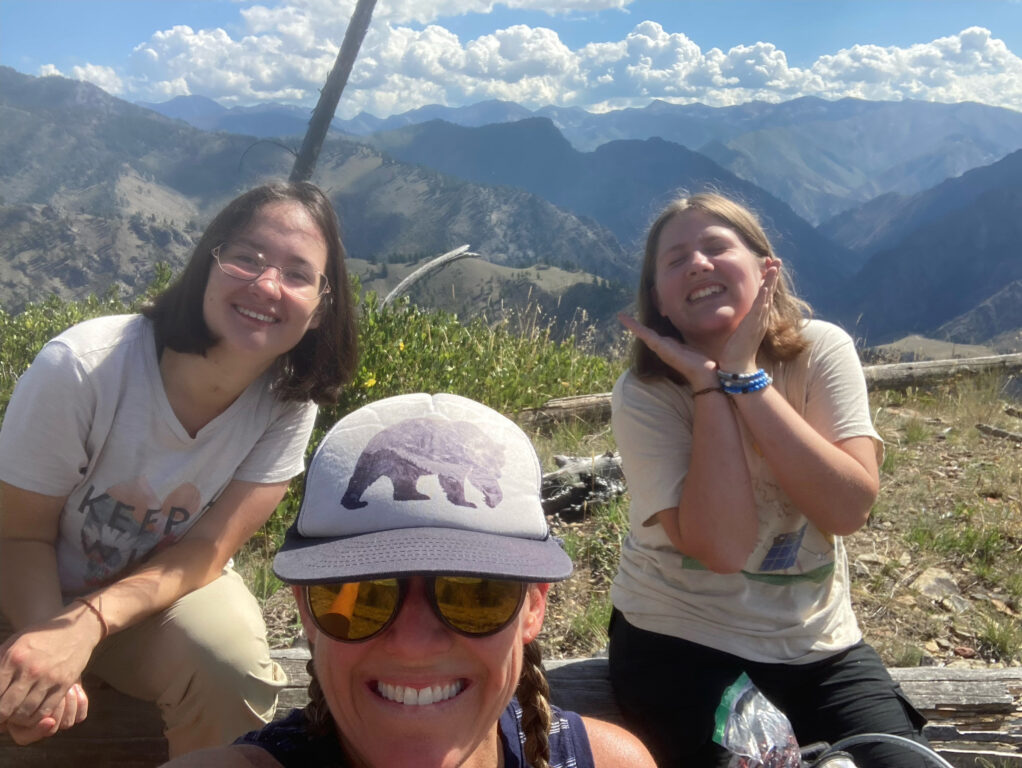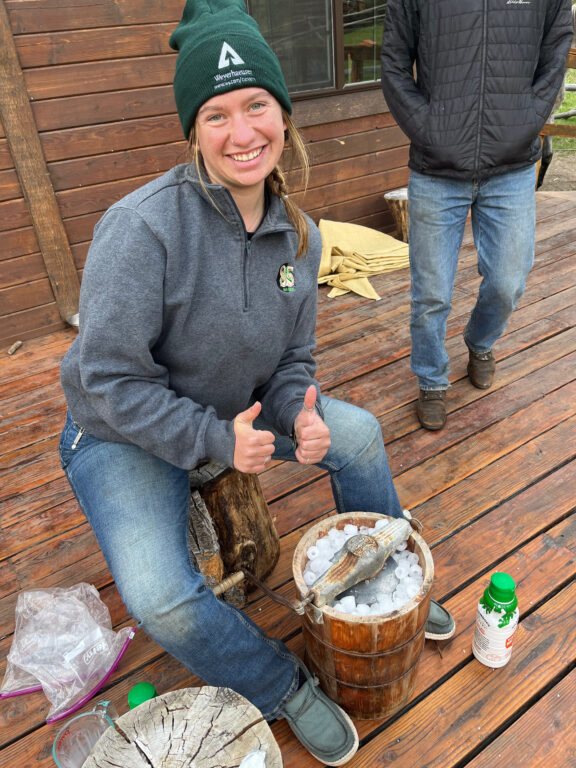The typical school year for a college student is already a chaotic experience. Throw living in the wilderness with 11 complete strangers into the mix, and you’ve hit the jackpot of insanity.
I first learned about the Semester in the Wild program when I was a junior in high school. A mentor of mine participated when she attended the University of Idaho and told me about how amazing it was.
Essentially, the experience is three months of living at the Taylor Wilderness Research Station in the heart of the Frank Church — River of No Return Wilderness in Central Idaho while learning about environmental history, ecology, sustainability and environmental writing. Fondly called “the Frank,” the wilderness area was designated by Congress in 1980 after the area was recommended by Senator Frank Church. The program had its first semester in 2013.
The station was originally a ranch owned and operated by “Cougar Dave” Lewis. He sold the 65-acre property to Jess Taylor and his wife in 1935, who were outfitters at the time. With the aid of scientist Dr. Maurice Hornocker, who based his study out of the ranch, UI purchased it from Taylor in 1969. It is now used as a hub for research and education for university programs.

Aside from her stint with giardiasis (an intestinal infection), my mentor’s experiences at Taylor convinced me to
participate. So, after submitting my application in the spring of my freshman year, attending a few information sessions and going to a chaotic bonfire with a few of the other folks participating, I was off.
On Aug. 21, we made our first stop on our way to the Frank. The McCall Outdoor Science School, or MOSS, in McCall, Idaho, is a satellite campus owned by the university and is often used for natural resources and science education programs.
My nerves were through the roof as I waited on a bench overlooking Payette Lake. This adventure was a decision made by an introvert pretending to be an extrovert, and the anxiety was setting in. I’d made impulsive decisions before, but this felt larger than anything I had previously done. After my mom left me at MOSS, forcing me to make awkward small talk with the one other person who had arrived at the campus, I was beginning to regret my impulsive decision. But other students arrived, icebreaker games were awkwardly played (names shared, forgotten, then shared again) and I slowly forgot the knot in my stomach.
“This adventure was a decision made by an introvert pretending to be an extrovert, and the anxiety was setting in.”
Eventually, the group hit the road in university vans and made its way to a little town called Edwardsburg, which sits a few miles outside of the Frank. There, we stayed for a week at Dr. Brian Kennedy’s cabin, who is a faculty member in the Department of Fish and Wildlife Sciences at UI. Some students stayed in tents outside, others staked their claim on the furnished second floor of the garage, while others (such as myself) took their chances with the cement floor of the garage. Despite its looks, the ground was quite comfortable.

While in Edwardsburg, we spent our days learning about how fires impact the ecology of the forest, the salmonid lifecycle, how the abundance and diversity of tiny insects called macroinvertebrates can say a lot about water quality and how to design our own ecological projects. Alongside our science curriculum, we also learned how to live with each other. We cooked for each other, told ghost stories around the campfire, went looking for wolves and enjoyed each other’s company while listening to small town musicians at the local lodge.
Our time in Edwardsburg was beautiful (including some rather interesting encounters with a guest fire-ecology lecturer), but the real adventure began when the group took its first steps on the 30-mile-trail leading to Taylor.
In an effort to do anything I can to make the great Bear Grylls proud, I spent a lot of time on trails and in tents situated in places that made my parents worry about me. The Big Creek Trail was a beast, and with this being my first real backpacking trip, it was like a beast on steroids.
“I spent a lot of time on trails and in tents situated in places that made my parents worry about me.”

The Frank Church Wilderness is over two million acres, about two-thirds of the area of Connecticut. It is home to talus slopes, giant crags and lodgepole-covered mountains that stretch towards the sky. The Middle Fork of the Salmon River flows through its heart and connects to other waterways that feed life into each basin. Each step on the trail brought us closer to Taylor while bringing new sights and experiences.
The first day was a difficult one. We had split into two groups and were slowly making our way along the trail but fell just one mile short of our 10-mile goal. Approaching our first campsite, we came across a cinnamon-colored black bear. Our teaching assistant (TA) spotted it first, but the group didn’t believe him and said he was seeing things. Eventually, though, we saw the young bear run up a hill just across the river from where we stood.
The second day was just as difficult, but the group was getting used to the effort and began to set a pace that helped us succeed in our goals. By the end of the day, my feet were throbbing and my water bottle was empty, but we had made it to Coxy Creek and set up camp. The difficulty with this campsite was that the nearest water source was at the end of a rather perilous trail which required an impromptu rock-climbing expedition. The way down was an easier feat than the way up—which saw me fall a good distance, but I was luckily saved by my trail buddy, Ryann.
It took us two more days to reach Taylor. During that time, we saw monuments of life from before the Frank was designated as Wilderness, as well as camps and abandoned homesteads that seasoned travelers discuss in their writings — like “Cougars on The Cliff: One Man’s Pioneering Quest to Understand the Mythical Mountain Lion,” which was written by Hornocker as a retelling of his time in the Frank. We felt the burning sensation of our legs giving out as we climbed the steep hill towards Acorn Creek and its abandoned airstrip, learned about the Duku Deka Tribe’s history at Cabin Creek and were frequently quizzed on the tree and shrub species we were seeing by our TA while he shared huckleberries found on the trail.

On the last stretch of the trail, after being often lied to about how much of the trail was left, we finally got our first look at Taylor. The ranch is nestled just off Big Creek and is in constant shadow of Dave Lewis Mountain towering just behind its perimeter.
After dropping our packs off at the canvas wall tents we would be living in until the weather turned, we received a tour of the property by the very eccentric caretaker, Andrew Armstrong.
History was a constant companion on the ranch, with some cabins dating back to the early years of the ranch and others named after important figures in the ranch’s past, as well as artifacts from past owners and residents of the ranch that are situated like trophies on the walls of the cookhouse and lab.
Taylor is a beautiful place and is run entirely by green energy. Solar panels are situated in spots where they receive optimal exposure and a hydropower system generates electricity for buildings.
The wall tents were nestled just uphill from Big Creek near a gated pen Dr. Hornocker built to house two orphaned cougars he adopted during his study in the 1960s. After the weather turned and got cold enough for snow, several of us moved into the DeVlieg cabin, which was the most recent building constructed on the 65 acres. Two students stayed in the wall tents for the entire semester, though, and I still don’t know how they accomplished that.
The Dave Lewis cabin was built just at the base of a mountain, meaning it was frequently the coldest spot on the ranch, as it was in constant shadow. This was where most of our professors stayed during their time with us.
The airstrip stretched along Big Creek and was lined with rows of deciduous trees often foraged on by beavers. At the end of the airstrip was a circle of tree stumps we used as an outdoor classroom, where we would discuss sustainability, the importance of wild places and the teachings of various environmental thinkers.
Throughout the three months the group lived and worked at Taylor, we learned so much about living in and embracing the Wilderness, as well as embracing the company we found along the way. We read John Muir and Gifford Pinchot while sitting on the bank of Big Creek; climbed mountains so we could see miles of forest and mountains; spent afternoons fishing and laughing near Rush Creek; studied pictographs on cliff faces in the Big Creek Gorge and gained valuable backcountry skills and experience in outdoor leadership.




We took every chance we had to explore the area surrounding Taylor. Groups went backpacking to various nooks and crannies of the Frank nearly every weekend, experiencing everything the Wilderness had to offer.
As an assignment for our outdoor leadership course, we planned and led a weeklong trip to anywhere of our choosing. The group agreed to pack to a campsite called Waterfall Camp in the Bighorn Crags. It was a trail that saw us climb up steep hills and rest along Big Creek and the Middle Fork of the Salmon River. It was a trip that tested us and saw us both fail (most prominently with a campsite made up entirely of rocks), as well as succeed. We saw flowing creeks and rivers, giant alpine lakes and ponderosas that smelled of vanilla while reaching for the sky.
“We saw flowing creeks and rivers, giant alpine lakes and ponderosas that smelled of vanilla while reaching for the sky.”
Spending three months in the Frank Church is difficult to compress into a single article. There were so many small, chance encounters that will forever be engrained in my being, but to share them all I would have to write a 1,000-page novel. I experienced everything from falling off a beaver dam and hurting my knee, to finding wolf tracks, to late-night movies, to classes held on a ridge overlooking Big Creek, to falling off a mule.

Unfortunately, the semester could not last forever, and we all had to say our goodbyes to the ranch and the mountains we had come to know so well. Our final adventure was boarding a bush plane that flew us back to the front country. The view from the plane was unlike anything I had seen before. While I could only enjoy it briefly before getting motion sickness, the sight of Dave Lewis Mountain, Rush Point, Rush Creek, Big Creek and so many other places I had journeyed to breezing past is one that I will never forget.
The Frank Church — River of No Return Wilderness is a special place, and the experiences I had along the journey of Semester in the Wild are invaluable. An infinite realm of knowledge lies within the foundation of this program, and the friendships and family found during the pursuit of that knowledge are forever worth the blisters on my feet and holes in my clothes.





